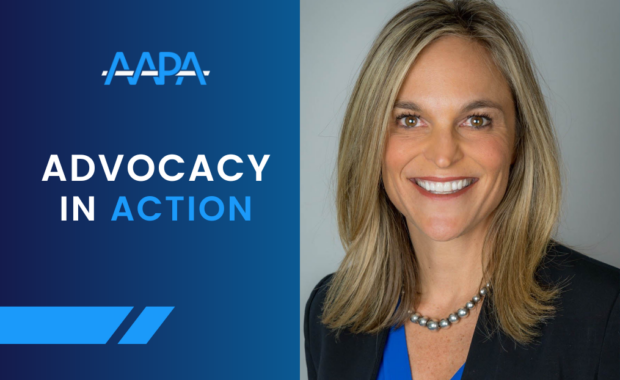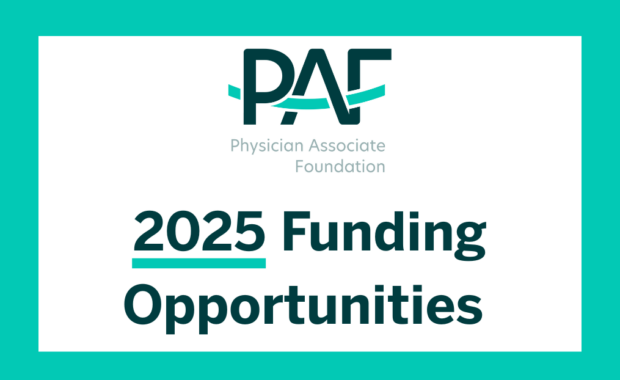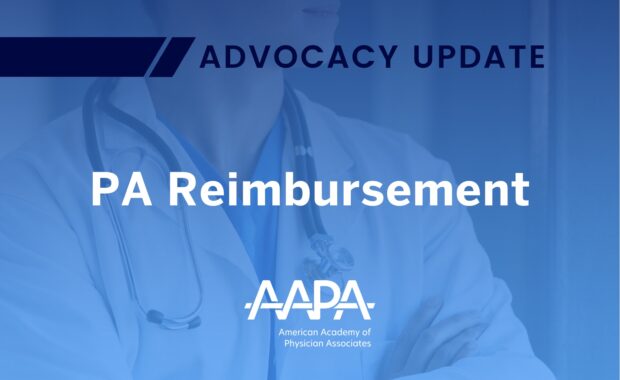The One Big Beautiful Bill Act (H.R. 1): What Every PA Needs to Know
July 16, 2025
By Tate Heuer, Vice President, Federal Advocacy
To ensure the PA community remains fully informed about the impact of the One Big Beautiful Bill Act (H.R. 1) on PAs and their patients – and where we go from here – AAPA has prepared the following overview. Please contact [email protected] with questions.
The Congressional Budget Reconciliation Process
The Congressional budget reconciliation process allows bills to pass the Senate with a majority vote, precluding filibusters, which require 60 votes to break.
The OBBB’s Path to Passage
The Senate passed its version of the bill on July 1 with three Republicans joining all Democrats in opposing the bill, and the House passed the Senate version of the bill on July 3 with two Republicans voting with all Democrats against the bill.
What’s in the bill?
Although the bill largely deals with extending tax cuts and reforms first enacted in 2017, it also makes several policy changes related to the financing of health care, student loans, and nutritional assistance. The bill’s proponents argued that these changes, which reduce federal spending, were necessary to offset the revenue projected by the Congressional Budget Office (CBO) to be lost due to extending the tax cuts and other spending measures included in the bill. The bill also makes a one-time increase to the Medicare Fee Schedule of 2.5% for 2026.
Estimates of Cost and Spending Cuts
The Joint Committee on Taxation estimates that the One Big Beautiful Bill Act will reduce revenue by $4.5 trillion between 2025 and 2034, while the CBO estimates it will also reduce spending by about $1 trillion over the same period. As of December 2024, Medicaid covers 78.5 million people, up from just under 50 million in 2009.
Coverage Loss Predictions
The CBO estimates that 11.8 million fewer people would have health coverage in 2034 due to the bill’s changes in Medicaid policy, while Medicaid spending is projected to rise at 3% over the next decade instead of 4.8% without these changes. This follows large increases in Medicaid enrollment and spending after the passage of the Affordable Care Act in 2010 and the Inflation Reduction Act in 2022. Because many of the changes made by the bill depend on state implementation, much will depend on the way states take up these new directives.
AAPA Actions Before the Final Vote
Prior to H.R. 1’s passage, AAPA joined other organizations in calling for Congress to “reject proposals that would destabilize primary care and the Medicaid funding which sustains many practices.” AAPA also joined a coalition to “urge the Senate to ensure that any final bill does not harm the ability of students working towards health professions degrees to pursue their education…”.
Key Bill Provisions: What PAs Need to Know
AAPA expects the bill’s changes to Medicaid/Children’s Health Insurance Program (CHIP), Student Loans, and the Supplemental Nutrition Assistance Program (SNAP) to have significant impacts on PAs and their patients.
Medicaid (amount of spending cut in parentheses)
- Work/Community Engagement Requirements ($326 billion): By 2027, adults who are physically able to work must affirm monthly that they spend no less than 80 hours per month working, participating in a work program, completing community service, participating in an educational program, or participating in a combination of those activities. Exceptions are made for certain individuals, including those under 19 years of age, those who are physically unable to work, and individuals experiencing certain short-term hardship events. $200 million is appropriated to assist state Medicaid programs in implementing these new requirements.
- State Enrollment and Eligibility Checks ($80 billion): Requires states to complete quarterly reviews of Death Master Files to verify deceased beneficiaries and providers do not remain enrolled in Medicaid programs. To prevent individuals from being simultaneously enrolled in two states, requires states to obtain enrollee address information by January 1, 2027, while requiring states to submit monthly enrollee social security numbers and other information by October 1, 2029. States must also complete eligibility redeterminations every six months starting in 2027. In addition to disenrolling people who are ineligible, others who might otherwise be eligible may lose coverage due to paperwork or administrative errors.
- Federal Matching Assistance Percentage (FMAP) reduction ($42 billion): In 2026, ends temporary COVID-era increased FMAP incentives for states that expanded Medicaid under the ACA. Limits FMAP for otherwise ineligible non-citizens receiving emergency Medicaid to state’s regular, non-expansion FMAP.
- Increased Cost-Sharing ($7 billion): Beginning in October 2028, states would be required to impose cost-sharing requirements on adults with incomes between 100% and 138% of the federal poverty level who were enrolled through the Affordable Care Act (ACA) Medicaid expansion. Cost-sharing cannot exceed $35, and would only apply to certain services, care or items furnished to Medicaid enrollees, excluding primary care, mental health, substance use disorder services, or services provided by federally qualified health centers (FQHCs), certified community behavioral health centers (CCBHCs) or rural health clinics. Cost-sharing cannot exceed 5 percent of a family’s income.
- Medicaid State Directed Payment Programs (DPPs) ($149 billion): Medicaid DPPs can pay providers up to average commercial rates (ACR). The bill establishes a new cap on these rates at 100 percent of Medicare payment rates for ACA expansion states and 110 percent for ACA non-expansion states. DPP programs that meet certain submission/approval deadlines would not see reductions phased in until 2028.
- State Provider Taxes ($225 billion): State provider taxes are a mechanism that allow states to tax providers, use the revenue to pay providers higher rates and to increase services, and to increase federal matching funding. Current law allows provider taxes up to 6 percent of provider revenues. Starting in 2028, the bill limits provider taxes in ACA expansion states (that have an enacted provider tax as of the date of enactment of the bill) through a gradually decreasing cap – from 5.5 percent of net patient revenues in 2028 down to 3.5 percent by 2032. Non-expansion states will be prohibited from imposing new provider taxes in certain situations but are not subject to the graduated step down to a 3.5 percent cap. Limits conditions under which states may receive a waiver of the requirement that taxes be broad-based and uniform, and allows states three fiscal years to conform current taxes.
- Rural Health Transformation Program: To address potential losses in funding for rural hospitals and health care facilities, the bill provides $50 billion over five years to hospitals and other providers. To qualify for funding, states must submit a rural health transformation plan by Dec. 31, 2025, outlining how the plan will improve access to care, patient outcomes, and the long-term success and financial viability of rural hospitals.
Student Loans
- Elimination of Grad PLUS: In July of 2026, subsidized direct loans (also called Grad PLUS) for graduate students would be eliminated. Grad PLUS borrowers can currently borrow an unlimited amount up to the full cost of attendance.
- New Loan Limits on Unsubsidized Direct Loans for Professional Students (when combined with eliminated Grad PLUS, $50 billion): The bill divides graduate school borrowers into “graduate” and “professional” borrowers and adopts new loan limits for unsubsidized direct loans based on these designations. PAs would be included under the “professional” category and would have loan amounts capped at $50,000 annually and $200,000 over the tenure of the PA program. Current law limits both graduate and professional borrowers to $138,500. Graduate limits are in addition to existing undergraduate limits.
- Student Loan Repayment Plans ($296 billion): Ends existing Income-Contingent Repayment (ICR) Plans for new borrowers beginning July 2026, and replaces them with a single Repayment Assistance Plan (RAP). Payments under RAP count toward Public Service Loan Forgiveness (PSLF) eligibility. The Department of Education will transition existing borrowers on an ICR to RAP or the existing income-based repayment (IBR) plan no later than July 1, 2028.
SNAP ($285 billion)
- Expanded Work Requirements: Able bodied adults ages 55 to 65 and parents or guardians of children over the age of 14 would be included under existing work requirements. Removes the Secretary of the Department of Agriculture (USDA) authority to issue work requirement waivers based on insufficient job openings to areas with an unemployment rate of more than 10 percent.
- State Cost-Sharing: Requires states to contribute a percentage of the cost of SNAP benefits based on their payment error rate beginning in fiscal year 2028. Reduces the federal cost share of administering SNAP from 50 percent to 25 percent beginning in fiscal year 2027.
- Eliminates the National Education and Obesity Prevention Grant Program: The National Education and Obesity Prevention Grant program (SNAP-Ed) provides funding to state and local organizations to provide information to SNAP beneficiaries to help them make healthy food choices and engage in physical activity to prevent or reduce the risk of obesity and related health problems.
You May Also Like
Advocacy in Action: Mid-Year Wins and Highlights
AAPA Shines Light on Barriers to PA Practice and Opportunities to Improve Care in Multiple Comment Letters to Agencies
AAPA Statement on Passage of the “Big Beautiful Bill”
Thank you for reading AAPA’s News Central
You have 2 articles left this month. Create a free account to read more stories, or become a member for more access to exclusive benefits! Already have an account? Log in.



